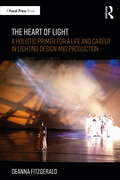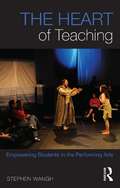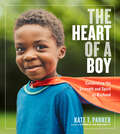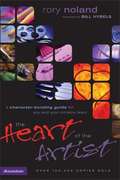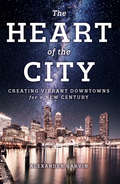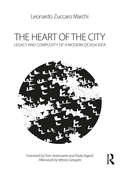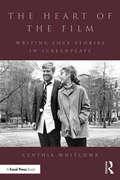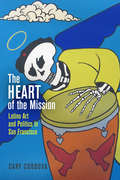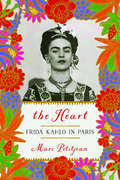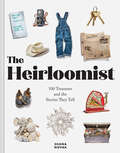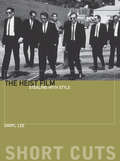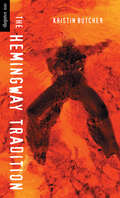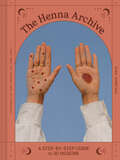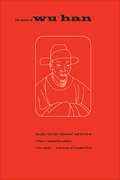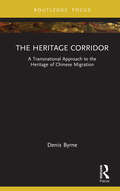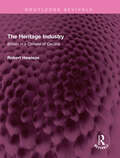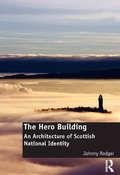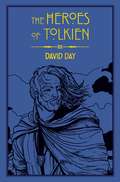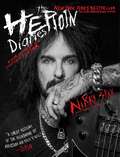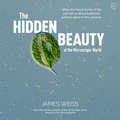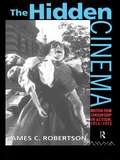- Table View
- List View
The Heart of Leonardo
by Francis C. WellsThis book contains all of Leonardo Da Vinci's drawings on the heart and its physiology, accompanied by re-translations of all of the associated notes. All Leonardo's drawings have been interpreted in the light of modern knowledge by a practicing cardiac clinician and anatomist. The veracity of his work is proven against contemporary dissections of cardiac structure and comparison of his illustrations with contemporary images generated by Magnetic Resonance scanners and high definition ultrasound will astound the reader. Perhaps the most interesting element is the re-dissection of the Ox heart set against Leonardo's own drawings. His place in the greater scheme of anatomical development will be put into context with his ideas of man's place in the microcosm/macrocosm continuum.
The Heart of Light: A Holistic Primer for a Life and Career in Lighting Design and Production
by Deanna FitzgeraldThe Heart of Light: A Holistic Primer for a Life and Career in Lighting Design and Production is a fresh look into the ever-evolving fields of lighting design and technology for arts and entertainment. Full of practical information, historic perspectives, engaging projects, and opportunities for deep inquiry, practice, and reflection, this book offers a well-rounded foundation in the art, technology, and industries of light. It explores a wide range of topics, including: how to observe, communicate about, and use light effectively how quietive practices can deepen the creative process current lighting equipment used across the various arts and entertainment industries and strategies for keeping up with its rapid innovation how to choose a career path that keeps you inspired, as well as ways to search for work with dos and don’ts of effective career building how to cope with and celebrate the unknown and related challenges of implementing a design under pressure considerations for using self-reflection to be successful and impact positive change From her perspective of lighting designer, educator, and contemplative practitioner, the author explores lighting not just as subject, but as an invitation to a fulfilling lifelong adventure. Written for students of Theatrical Lighting courses and emerging lighting professionals, The Heart of Light is a must-read for anyone intrigued by the power of light.
The Heart of Teaching: Empowering Students in the Performing Arts
by Stephen WanghThe Heart of Teaching is a book about teaching and learning in the performing arts. Its focus is on the inner dynamics of teaching: the processes by which teachers can promote—or undermine—creativity itself. It covers the many issues that teachers, directors and choreographers experience, from the frustrations of dealing with silent students and helping young artists ‘unlearn’ their inhibitions, to problems of resistance, judgment and race in the classroom,. Wangh raises questions about what can—and what cannot—be taught, and opens a discussion about the social, psychological and spiritual values that underlie the skills and techniques that teachers impart. Subjects addressed include: Question asking: which kinds of questions encourage creativity and which can subvert the learning process. Feedback: how it can foster both dependence and independence in students. Grading: its meaning and meaninglessness. Power relationships, transference and counter-transference The pivotal role of listening. The Heart of Teaching speaks to experienced teachers and beginning teachers in all disciplines, but is particularly relevant to those in the performing arts, from which most of its examples are drawn. It brings essential insight and honesty to the discussion of how to teach.
The Heart of a Boy: Celebrating the Strength and Spirit of Boyhood
by Kate T. ParkerIt’s time to celebrate boys. Against the backdrop of a growing national conversation about how to raise sons to become good people, Kate T. Parker is leading the way by turning her lens on boys. Author of the bestselling book about girls Strong Is the New Pretty, she now shows the true heart of a boy in 200 compelling photographs. Boys can be wild. But they can also be gentle. Bursting with confidence, but not afraid to be vulnerable. Ready to run fearlessly downfield—or reach out to a friend in need. In this empowering, deeply felt celebration of boys being—and believing in—themselves, see the unguarded joy of a little brother hugging his big brother. The inquisitive look of a young scientist examining a bug. The fearless self-expression in a ballet dancer’s poise. There are guitarists, fencers, wrestlers, stargazers, a pilot. Boys who aspire to be president, and boys whose lives are full of overwhelming challenges, yet who bravely face each day as it comes. With inspiring and joyful quotes from the boys themselves, this book spreads a heartfelt, uplifting message of openness, self-confidence, and warmth. “Kate T. Parker’s incredible Strong Is the New Pretty helped us reimagine girlhood as silly, messy, spirited, and fun. Now she turns her perceptive lens on the other sex to expand our definition of what it means to be a boy . . . and presents something desperately needed in our well-meaning cultural conversation about boys—she shows us their enormous, wonderful hearts.”—Michael Ian Black, actor and writer “Silly, serious, nerdy, athletic, creative, bold—the adjectives describing boys could go on for pages. But if boys are to grow up to be admirable men, the one thing they must be is kind. Kate T. Parker’s book helps clear the way for a time when everyone understands that.” — R. J. Palacio, #1 New York Times bestselling author of Wonder “Every parent who picks up this book will be grateful for the impact it will have on their family.” —Gary Vaynerchuk, author of Crushing It!
The Heart of the Artist: A Character-Building Guide for You and Your Ministry Team
by Rory NolandTalks about people with an artistic temperament and the struggles that they can have as they try and serve God and how they can use their gifts effectively with discipline.
The Heart of the City: Creating Vibrant Downtowns for a New Century
by Alexander GarvinDowntowns are more than economic engines: they are repositories of knowledge and culture and generators of new ideas, technology, and ventures. They are the heart of the city that drives its future. If we are to have healthy downtowns, we need to understand what downtown is all about; how and why some American downtowns never stopped thriving (such as San Jose and Houston), some have been in decline for half a century (including Detroit and St. Louis), and still others are resurging after temporary decline (many, including Lower Manhattan and Los Angeles). The downtowns that are prospering are those that more easily adapt to changing needs and lifestyles.In The Heart of the City, distinguished urban planner Alexander Garvin shares lessons on how to plan for a mix of housing, businesses, and attractions; enhance the public realm; improve mobility; and successfully manage downtown services. Garvin opens the book with diagnoses of downtowns across the United States, including the people, businesses, institutions, and public agencies implementing changes. In a review of prescriptions and treatments for any downtown, Garvin shares brief accounts—of both successes and failures—of what individuals with very different objectives have done to change their downtowns. The final chapters look at what is possible for downtowns in the future, closing with suggested national, state, and local legislation to create standard downtown business improvement districts to better manage downtowns.This book will help public officials, civic organizations, downtown business property owners, and people who care about cities learn from successful recent actions in downtowns across the country, and expand opportunities facing their downtown. Garvin provides recommendations for continuing actions to help any downtown thrive, ensuring a prosperous and thrilling future for the 21st-century American city.
The Heart of the City: Legacy and Complexity of a Modern Design Idea
by Leonardo Zuccaro MarchiThe Heart of the City concept, which was introduced at CIAM 8 in 1951, has played an important role in architectural and urban debates. The Heart became the most important of the organic references used in the 1950s for defining a theory of urban form. This book focuses on both the historical and theoretical reinterpretation of this seminal concept. Divided into two main sections, both looking at differing ways in which the Heart has influenced more recent urban thinking, it illustrates the continuity and the complexities of the Heart of the City. In doing so, this book offers a new perspective on the significance of public space and shows how The Heart of the City still resonates closely with contemporary debates about centrality, identity and the design of public space. It would be of interest to architects, academics and students of urban design and planning.
The Heart of the Film: Writing Love Stories in Screenplays
by Cynthia WhitcombMost movies include a love story, whether it is the central story or a subplot, and knowing how to write a believable relationship is essential to any writer's skill set. Discover the rules and laws of nature at play in a compelling love story and learn and master them. Broken into four sections, The Heart of the Film identifies the critical features of love story development, and explores every variation of this structure as well as a diverse array of relationships and types of love. Author Cynthia Whitcomb has sold over 70 feature-length screenplays and shares the keys to her success in The Heart of the Film, drawing on classic and modern films as well as her own extensive experience.
The Heart of the Mission: Latino Art and Politics in San Francisco
by Cary CordovaIn The Heart of the Mission, Cary Cordova combines urban, political, and art history to examine how the Mission District, a longtime bohemian enclave in San Francisco, has served as an important place for an influential and largely ignored Latino arts movement from the 1960s to the present. Well before the anointment of the "Mission School" by art-world arbiters at the dawn of the twenty-first century, Latino artists, writers, poets, playwrights, performers, and filmmakers made the Mission their home and their muse.The Mission, home to Chileans, Cubans, Guatemalans, Mexican Americans, Nicaraguans, Puerto Ricans, and Salvadorans never represented a single Latino identity. In tracing the experiences of a diverse group of Latino artists from the 1940s to the turn of the century, Cordova connects wide-ranging aesthetics to a variety of social movements and activist interventions. The book begins with the history of the Latin Quarter in the 1940s and the subsequent cultivation of the Beat counterculture in the 1950s, demonstrating how these decades laid the groundwork for the artistic and political renaissance that followed. Using oral histories, visual culture, and archival research, she analyzes the Latin jazz scene of the 1940s, Latino involvement in the avant-garde of the 1950s, the Chicano movement and Third World movements of the 1960s, the community mural movement of the 1970s, the transnational liberation movements in Nicaragua and El Salvador, and the AIDS activism of the 1980s. Through these different historical frames, Cordova links the creation of Latino art with a flowering of Latino politics.
The Heart: Frida Kahlo in Paris
by Marc PetitjeanThis intimate account offers a new, unexpected understanding of the artist’s work and of the vibrant 1930s surrealist scene. In 1938, just as she was leaving Mexico for her first solo exhibition in New York, Frida Kahlo was devastated to learn from her husband, Diego Rivera, that he intended to divorce her. This latest blow followed a long series of betrayals, most painful of all his affair with her beloved younger sister, Cristina. In early 1939, anxious and adrift, Kahlo traveled from the United States to France—her only trip to Europe and the beginning of a unique period of her life when she was enjoying success on her own. Now, for the first time, this previously overlooked part of her story is brought to light in exquisite detail. Marc Petitjean takes the reader to Paris, where Kahlo spends her days alongside luminaries such as Pablo Picasso, André Breton, Dora Maar, and Marcel Duchamp. Using Kahlo’s whirlwind romance with the author’s father, Michel Petitjean, as a jumping-off point, The Heart: Frida Kahlo in Paris provides a striking portrait of the artist and an inside look at the history of one of her most powerful, enigmatic paintings.
The Heartbreakers (The Heartbreak Chronicles #1)
by Ali Novak"When I wasn't reading this book, it was all I wanted to be doing. Adorably romantic and fun! I loved it." —Kasie West author of The Distance Between UsFrom beloved Wattpad sensation Ali Novak, author of My Life with the Walter Boys, comes this swoon-worthy YA romcom about a teen who accidentally falls for the lead singer of a world-famous boy band, perfect for fans of Jenny Han and Miranda KenneallyWhen I met Oliver Perry, I had no clue he was the lead singer for The Heartbreakers. And he had no idea that I was the only girl in the world who hated his music.Stella will do anything for her sick sister, Cara—even stand in line for an autographed Heartbreakers CD…for four hours. She's totally winning best birthday gift this year. At least she met a cute boy with soft brown hair and gorgeous blue eyes while getting her caffeine fix. Too bad she'll never see him again.Except, Stella's life has suddenly turned into a cheesy love song. Because Starbucks Boy is Oliver Perry—lead singer for the Heartbreakers. And even after she calls his music crap, Oliver still gives Stella his phone number. And whispers quotes from her favorite Disney movie in her ear. OMG, what is her life?But how can Stella even think about being with Oliver—dating and laughing and pulling pranks with the band—when her sister could be dying of cancer?First a hit on the online community Wattpad, Ali Novak's second novel has over 38 million reads and is loved by readers around the world.With a perfect balance of humor, heart, and romance, The Heartbreakers is a great choice for readers looking for:fun contemporary romance for teensWattpad love storiesromcoms that cover deeper issues like family, illness, and self-discoverybinge-worthy YA novels
The Heirloomist: 100 Treasures and the Stories They Tell
by Shana NovakA warm, inviting celebration of beloved keepsakes and the stories they hold.A set of old apartment keys, a pair of worn running shoes, a declaration of love scribbled on a restaurant receipt. Beautiful stories that celebrate the power an object can hold are at the heart of The Heirloomist by photographer Shana Novak, creator of the project of the same name dedicated to documenting keepsakes and transforming them into uniquely meaningful works of art. The 100 objects featured here range from the everyday to the extraordinary. Treasured heirlooms to their owners, ordinary folks and cultural figures alike, they hold remarkable stories such as:Nora McInerny on the fork that began her relationship with her late husband.The sculpture that inspired Christy Turlington to fight for maternal healthcare.The charm bracelet Nate Berkus gifted his daughter in stylish family tradition.Rosanne Cash’s love for her children represented by baby shoes.Andrew Zimmern’s inherited steel carving set that began a storied career in food.Big or small, expensive or humble, we all have meaningful items with powerful messages behind them. Celebratory, sentimental, and bursting with heart, The Heirloomist offers a glimpse into the treasures we hold dear and how they inform the stories of our lives.HEARTWARMING GIFT: The stories attached to these heirlooms range from funny to moving and everything in between. An artful and touching memory book, it makes a sentimental gift for Mother's Day, Father's Day, graduation, housewarming, or any special occasion. Also perfect for anyone looking for unique stories.FOR FANS ART BOOKS LIKE HUMANS OF NEW YORK: The Heirloomist contains dozens of striking portraits of seemingly ordinary objects along with fascinating stories that will resonate with readers long after they've been read. The ultimate coffee table book, it is at once visually engaging and warmly entertaining.BASED ON A BELOVED BRAND: Through her business and popular Instagram account of the same name, photographer Shana Novak turns treasured keepsakes into uniquely meaningful works of art. As @theheirloomist, Shana has become a living receptacle for her clients’ stories, absorbing them as she strives to capture the essence of what makes each keepsake special to its owner in her photographs, and sharing them with her strong audience of devoted followers.Perfect for:Fans of The Heirloomist project and @theheirloomist social media accountsLovers of found objects and the stories behind themPhotography enthusiasts and photography book collectorsAnyone seeking unique Mother's Day or Father's Day giftsReaders of the New Yorker and story collections such as Humans of New York, Advanced Style, and Worn Stories
The Heist Film
by Daryl LeeA concise introduction to the genre about that one last big score, The Heist Film: Stealing With Style traces this crime thriller's development as both a dramatic and comic vehicle growing out of film noir ( Criss Cross, The Killers, The Asphalt Jungle), mutating into sleek capers in the 1960s ( Ocean's Eleven, Gambit, How to Steal a Million) and splashing across screens in the 2000s in remake after remake ( The Thomas Crown Affair, The Italian Job, The Good Thief). Built around a series of case studies ( Rififi, Bob le Flambeur, The Killing, The Lavender Hill Mob, The Getaway, the Ocean's trilogy), this volume explores why directors of such varied backgrounds, from studio regulars (Siodmak, Crichton, Siegel, Walsh and Wise) to independents (Anderson, Fuller, Kubrick, Ritchie and Soderbergh), are so drawn to this popular genre.
The Heist Film: Stealing with Style (Short Cuts)
by Daryl LeeA concise introduction to the genre about that one last big score, The Heist Film: Stealing With Style traces this crime thriller's development as both a dramatic and comic vehicle growing out of film noir (Criss Cross, The Killers, The Asphalt Jungle), mutating into sleek capers in the 1960s (Ocean's Eleven, Gambit, How to Steal a Million) and splashing across screens in the 2000s in remake after remake (The Thomas Crown Affair, The Italian Job, The Good Thief). Built around a series of case studies (Rififi, Bob le Flambeur, The Killing, The Lavender Hill Mob, The Getaway, the Ocean's trilogy), this volume explores why directors of such varied backgrounds, from studio regulars (Siodmak, Crichton, Siegel, Walsh and Wise) to independents (Anderson, Fuller, Kubrick, Ritchie and Soderbergh), are so drawn to this popular genre.
The Hemingway Tradition (Orca Soundings)
by Kristin ButcherShaw Sebring is sixteen and trying desperately to understand and accept his father's recent suicide. Moving with his mother halfway across the county in an effort to distance themselves from the awful truth, Shaw lands in a new school and finds that the ghost of his father, a best-selling author, has followed him. Determined that he will not follow in his father's footsteps Shaw tries to chart his own course, until circumstances force him to accept that where--and who--we come from have an impact on what we become.
The Henna Archive: 30 Designs and Their Stories, from Traditional to Modern
by Azra KhamissaWith detailed how-tos, evocative stories, and expert advice, this curated collection of 30 beautiful, easily reproducible designs by henna expert Azra Khamissa captures the past, present, and future of henna. Applied intricately to hands before celebrations, spread thickly on the soles of feet to protect the skin, or drawn in loose lines and shapes as a form of creative expression: Henna is all these things and more. Using her deep love for henna and tapping into her years of hosting henna workshops, designer and chiropractor Azra Khamissa fuses her own unique designs with historical and traditional inspiration to create The Henna Archive, a guide with 30 approachable designs that you can create at home.Inside you’ll find historical designs from Libya, Algeria, the United Arab Emirates, Morocco, and more, as well as designs of Khamissa’s own creation: leopard prints, crescent moons, Japanese knots, and flowers. Touching stories from people around the world sharing their personal connections to henna pair with the designs and illuminate the intimate nature of this ancient body art. Included are detailed how-tos to take your henna practice to the next level and tips, like how to get the perfect stain, what to look for when shopping for the best quality henna products, and how to host your own henna party.UNIQUE DESIGNS: Included among the historical designs are 20 of Azra's own creation, designs that her many followers and fans have loved re-creating on their own and that will inspire you to explore henna for yourself. A CELEBRATION OF HENNA: No other book has explored the stories and people behind the art form of henna in such a beautiful way. The designs inside uniquely capture the diverse applications, places, and people who love henna. BEAUTIFUL GIFT: Filled with striking photography and detailed instructions, this book is the perfect gift for both beginners and henna experts alike or anyone looking to explore this art form.Perfect for:Engagement party, bridal shower, wedding, or Eid al-Fitr gift Fans of henna, mendhi, or temporary tattooing looking for DIY design ideasGreat art activity for a girls’ night, bachelorette party, slumber parties, and moreThose who enjoy calligraphy, hand lettering, drawing, or anyone looking for a new art practice
The Heresy of Wu Han: His play 'Hai Jui's Dismissal' and its role in China's Cultural Revolution
by Clive AnsleyAt the centre of China's Cultural Revolution in its first stages stands the ambiguous figure of Wu Han. Occupying until the mid-sixties a favoured position among the intellectual elite of the People's Republic, he was the eighth-ranking figure in the Chinese Communist Party, and his Peking Opera Hai Jui's Dismissal was performed all over China. Gradually it became apparent that Wu Han was using Hai Jui to lampoon Chairman Mao Tse-tung and the core policies of the CPP. Other dissidents began to pen articles and plays on similar themes. For several years Mao chafed under these literary attacks, but in late 1965 he retaliated. A sudden, scathing attack on Wu Han and his play by an obscure newspaper editor marked the beginning of the Cultural Revolution, a cataclysm in which the Party leadership was decimated while Mao regained full supremacy. This volume presents the first translation of Wu Han's plays and helps to clarify the obscure origins of a national phenomenon that was at once intellectual, social, and political.
The Heretical Archive: Digital Memory at the End of Film
by Domietta TorlascoThe Heretical Archive examines the relationship between memory and creation in contemporary artworks that use digital technology while appropriating film materials. Domietta Torlasco argues that these digital films and multimedia installations radically transform our memory of cinema and our understanding of the archive. Indeed, such works define a notion of archiving not as the passive preservation of audiovisual signs but as an intervention and the creative rearticulation of cinema&’s perceptual and political textures. Connecting psychoanalysis, phenomenology, and feminist theory in innovative ways, Torlasco analyzes cutting-edge digital works that engage with the past of European cinema and visual culture, including video installations by Monica Bonvicini (Destroy She Said) and Pierre Huyghe (The Ellipsis), Agnès Varda&’s film The Gleaners and I, Marco Poloni&’s multimedia installation The Desert Room, and Chris Marker&’s CD-ROM Immemory. Torlasco&’s central claim is that if the archives of psychoanalysis and cinema have long privileged the lineage that runs from Oedipus to Freud, the archives of the digital age—what she calls the &“heretical archive&”—can help us imagine an unruly, porous, multifaceted legacy, one in which marginal figures return to speak of lost life as much as of life that demands to be lived.
The Heritage Corridor: A Transnational Approach to the Heritage of Chinese Migration (Routledge Research on Museums and Heritage in Asia)
by Denis ByrneThe Heritage Corridor argues for a transnational approach to investigating and recording heritage places that emerge from histories of migration. Addressing the material legacy of migration, this book also relates it to issues of contemporary importance. Presenting an image of the built environment of migration as one shaped by the ongoing flows of people, ideas, objects and money that circulate through migration corridors, Byrne proposes that houses and other structures built by migrants in their home villages in China over the period 1840–1940 should be seen as crystallisations of the labour, aspirations and longings enacted and experienced by their builders while overseas. Demonstrating that the material world of the migrant is distributed across transnational space, the book calls for an approach to the heritage of migration that is similarly expansive. It proposes and illustrates new methods and strategies for heritage practice. The Heritage Corridor is a book for scholars and students in the fields of critical heritage studies, migration studies and Chinese diasporic mobilities. It is designed to be accessible to heritage practitioners, readers with an interest in the material worlds of migration, past and present, and to all those with an interest in the ‘archaeology’ of transnational migration.
The Heritage Industry: Britain in a Climate of Decline (Routledge Revivals)
by Robert HewisonFirst published in 1987, The Heritage Industry sets out to protect the present and the future of life in Britain from their most dangerous enemy: a creeping takeover by the past. The author sets today’s obsession with yesterday in the context of a climate of social and political decline. The economic uncertainties and cultural convulsions of post-war life have made the past seem a pleasanter and safer place. But how true is that image of the past, and whose past is it, anyway? Hewison questions the way institutions like the National Trust are helping to create a past that never was. While the real economy crumbles, a new force is taking over: the Heritage Industry, a movement dedicated to turning the British Isles into one vast open-air museum. This book will be of interest to students of history, art and cultural studies.
The Hero Building: An Architecture of Scottish National Identity
by Johnny RodgerWhy was it that, across Scotland over the last two and a half centuries, architectural monuments were raised to national heroes? Were hero buildings commissioned as manifestations of certain social beliefs, or as a built environmental form of social advocacy? And if so, then how and why were social aims and intentions translated into architectural form, and how effective were they? A tradition of building architectural monuments to commemorate national heroes developed as a distinctive feature of the Scottish built environment. As concrete manifestations of powerful social and political currents of thought and opinion, these hero buildings make important statements about identity, the nation and social history. The book examines this architectural culture by studying a prominent selection of buildings, such as the Burns monuments in Alloway, Edinburgh and Kilmarnock, the Edinburgh Scott Monument, the Glenfinnan Monument and the Wallace Monument in Stirling. They give testimony to how a variety of architectural forms and styles can be adapted through time to bear particular social messages of symbolic weight. This tradition, which literally allows us to dwell on important social issues of the past, has been somewhat neglected in serious architectural history and heritage, and indeed one of the main monuments has already been destroyed. By raising awareness of this rich architectural and social heritage, while analysing and interpreting the buildings in their historical context, this book makes an exciting and original scholarly contribution to the current debates on identity and nationality taking place in Scotland and the wider UK.
The Heroes of Tolkien: An Exploration of Tolkien's Heroic Characters, and the Sources that Inspired his Work from Myth, Literature and History (Tolkien)
by David DayIn J. R. R Tolkien's Lord of the Rings, The Hobbit and The Silmarillion, Middle-earth endured cataclysmic wars and critical battles, causing great men, women and mystical creatures to arise, influence and shape the course of its history. Here in this book, Tolkien expert David Day examines the complexities surrounding Tolkien's portrayal of good and evil, and analyses Middle-earth's most celebrated heroes and the literary, historical and mythological sources that inspired their creation.This work is unofficial and is not authorized by the Tolkien Estate or HarperCollins Publishers.
The Heroin Diaries: A Year in the Life of a Shattered Rock Star
by Nikki SixxIn one of the most unique memoirs of addiction ever published, MÖtley CrÜe's Nikki Sixx shares mesmerizing diary entries from the year he spiraled out of control in a haze of heroin and cocaine, presented alongside riveting commentary from people who were there at the time, and from Nikki himself. When MÖtley CrÜe was at the height of its fame, there wasn't any drug Nikki Sixx wouldn't do. He spent days -- sometimes alone, sometimes with other addicts, friends, and lovers -- in a coke and heroin-fueled daze. The highs were high, and Nikki's journal entries reveal some euphoria and joy. But the lows were lower, often ending with Nikki in his closet, surrounded by drug paraphernalia and wrapped in paranoid delusions. Here, Nikki shares those diary entries -- some poetic, some scatterbrained, some bizarre -- and reflects on that time. Joining him are Tommy Lee, Vince Neil, Mick Mars, Slash, Rick Nielsen, Bob Rock, and a host of ex-managers, ex-lovers, and more. Brutally honest, utterly riveting, and shockingly moving, The Heroin Diaries follows Nikki during the year he plunged to rock bottom -- and his courageous decision to pick himself up and start living again.
The Hidden Beauty of the Microscopic World: What the tiniest forms of life can tells us about existence and our place in the universe
by James WeissThe videographer behind the Journey to the Microcosmos YouTube channel (386K subscribers) James Weiss presents a beginner's guide to the extremely small and utterly strange life that surrounds us.James Weiss was feeling lost in life when he first discovered his interest in the microscopic world. With his own microscope and a little homespun ingenuity, he began to capture thousands of hours of stunning footage of the creatures that he found around him: the local pond, at the beach, in a puddle. What he found astounded him, and it became his mission to reveal the beauty of the microcosmos to everyone.In his fun and accessible style, interspersed with otherworldly photographs, James presents this beginner's guide to the invisible life that surrounds us. From the most simple single-celled life, to complex micro-animals, James reveals the secrets of a world that we rarely consider. Navigating the births, feasts, tragedies, idiosyncracies and deaths of a cast of tiny characters, learn how these lifeforms work and what lessons they can teach us about our own existence. Mixing scientific detail with thoughtful musings that betray the fascination at the heart of his topic, James has created a way of looking at microorganisms in an empathetic and engaging style.You'll discover fascinating absurdities: that a cell can be both its own daughter and its own mother. That immortality really does exist, and it comes in the form of a teeny, tentacled medusa. And that seeing the wonder of nature from a new perspective can literally save your life.
The Hidden Cinema: British Film Censorship in Action 1913-1972 (Cinema and Society)
by James Robertson Dr James RobertsonHow does film censorship work in Britain? Jim Robertson's new paperback edition of The Hidden Cinema argues that censorship has had a far greater influence on British film history than is often apparent, creating the `hidden cinema' of the title. Robertson charts the role of the British Board of Film Censors, established in 1913, and the histories of a variety of noteworthy films including Battleship Potemkin and No Orchids for Miss Blandish and revealing how censorship continues to exert a marked influence on many important films - like the controversial A Clockwork Orange - some of which have now vanished from British screens altogether. This edition includes a brand new section on Bernardo Bertolucci's Last Tango in Paris, immediately engulfed in censorship wrangles on its release in 1972.

